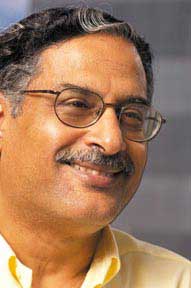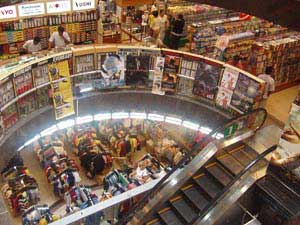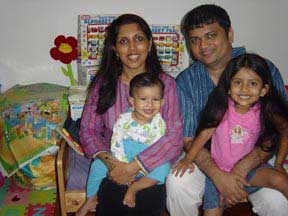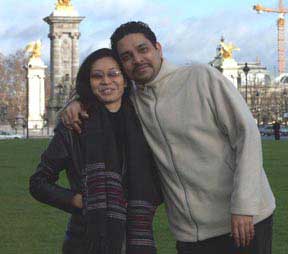Arts
Indians Roar In The Lion City

A new breed of professional Indian expatriates are radically transforming the Indian disapora in Singapore.
|
Although Indians constitute only 8 percent of Singapore’s population, they have become a major ingredient in the mixed racial salad bowl of this city state – South East-Asia’s most hi-tech and wealthiest country. The flavors of the Indian curries, of Roti Prata, Thosai and Briyani, the festivities of Dipawali and Thaipusam, and the song and dance of Indian movies, are all an integral part of the socio-cultural landscape of Singapore.
“Being a creative and entrepreneurial group, Indians are a great asset to our economy,” Prime Minister Lee Hsien Loong once commented on the community. “Indians have fared brilliantly in Singapore,” says Deepika Shetty, a producer with Channel NewsAsia, a major television network. “You see them in the top echelons everywhere, right from journalism to entrepreneurs. Well, Singapore’s president is Indian. Need I say more?”
Many Indians have indeed thrived in Singapore’s multi-racial, multi-religious and merit-driven society. After Singapore’s independence in 1965 many of them were propelled into senior political positions. The current president of Singapore, Sellapan Ram Nathan, is of Indian descent. Earlier, another Indian, C. V. Devan Nair served as president from 1981-1985. Singapore’s present Deputy Prime Minister, Professor Shunmugam Jayakumar is of Indian descent, as are two other cabinet ministers: Tharman Shanmugaratnam, Minister for Education, and Vivian Balakrishnan, Minister for Community Development, Youth and Sports, and Second Minister for Trade and Industry.
Singaporean Indians have distinguished themselves as judges, doctors, civil servants, air force commanders, entrepreneurs, artists, union leaders, teachers, and academics. J.Y. Pillai has led Singaopore Airlines to world renown. A. Vijaratnam is the engineering brain behind the posh Changi International Airport and the Port Authority of Singapore. S. Dhanabalan is chairman of DBS Group Holdings and Tamasek Board of Directors, Singapore’s prime investment company managing a diversified portfolio of $60 billion. According to the Singapore government’s census figures, the proportion of Indians in professional, managerial, executive and technical occupations doubled in the last 10 years. Since the 1990s, the Singaporean Indians have been bolstered by their proximity with India, as Singapore has sought to ride on India’s economic growth. After India opened up its economy, bilateral trade between the two countries boomed, as did tourism and investments. Singapore signed a Comprehensive Economic Cooperation Agreement with India this year, bringing the two countries closer than ever. Indian companies already see Singapore as a solid base; 1,400 have set up offices in Singapore, comprising the fourth largest contingent of foreign firms.
“India’s economic progress has definitely helped us improve our image within Singapore,” says Anees Khan, a second generation Singaporean Indian. He was still a baby when his parents migrated to Singapore three decades ago. His father started a food business and the family thrived. Khan was educated in Singapore and now works as a programmer. “When Indians go to the job market today, especially in the IT field, India’s image as an IT powerhouse rubs on them. Getting a job then becomes a little easier.” Singapore is among the world’s tiniest countries with a total land area of just 266 square miles, about three times the size of Washington, D.C. It comprises of one main island and 63 tiny islands, most of which are uninhabited. This cosmopolitan city has a population of about 4.5 million, of which 77 percent are Chinese, 14 percent Malay and 8 percent Indian. The vast majority of the 350,000 Indians in Singapore, almost 64 percent, are Tamilian. They are followed by Punjabis, 8 percent; Malyalis, 8 percent; Sindhis 6 percent; and Gujaratis 2 percent. Almost a quarter of the Indian population, 90,000, are permanent residents – noncitizens who live and work in Singapore, mostly as financial services professionals, computer engineers, construction labor and domestic help.
During the past decade, Singapore’s Indian community has been transformed by the invasion of high tech Indian professionals, similar to the impact these professionals had in the United States. Until the high tech boom, the Indian labor pool comprised principally of blue collar construction workers and domestic help. Fewer than 9 percent of Indian expats (permanent residents) in 1990 held a college degree. By contrast, in 2000 almost 51 percent of Indian permanent residents were college educated. Singapore’s Indian citizens have noticeably lower academic credentials: fewer than 8 percent of Singapore Indian citizens have a college degree, for example. Since expat Indians account for almost a quarter of Singapore’s Indian population, the new, educated, high income Indian professionals have altered the overall community demographics in dramatic ways. In the last ten years, the proportion of Indian blue collared workers has halved, from about 15 percent to 8 percent, while the proportion of the professionals and managerial workers has doubled from about 22 percent to 43 percent of the total Indian workforce, revolutionizing the image of Indians in the Singaporean society. Culture and Cuisine
Indian migration to Singapore dates back two centuries and their impact on Singapore society is pervasive. Yoga, Indian dances and Indian cuisine are exceedingly popular among Singaporeans. Indian dances, mostly Bollywood-inspired, are taught in some community centers. The sight of Chinese children wearing ghaghra-choli performing perfect gyrations to Bollywood dance numbers on stage in community gatherings during the Chinese 7th month festivities is commonplace. Similarly, Indian food is as much part of Singaporean cuisine as Chinese or Malay food. In Little India, Singapore’s famous Indian enclave, large numbers of Chinese and Malay families can be seen enjoying Indian fare in restaurants and eateries on any given day. Over 100 Indian restaurants thrive in the city. In addition, any hawker center or food court offer one or more Indian food stalls. Komala Vilas, a favorite Indian haunt in Serangoon Road, dishes out all-you-can-eat Indian food for $3 (Singapore $5) to over 3,000 diners daily in two of its branches. “We are following the Indian tradition of providing good food at a reasonable price,” says Rajoo Gunasekaran, proprietor of Komala Vilas. Gunasekaran’s father, Raju Gunasekaran, came to Singapore at age 15 from Tanjor, Tamil Nadu, in 1937. “My father started working in this restaurant and later on, in 1947, he bought it,” Gunasekaran says. He and his brother now run a very successful chain of Indian restaurants in Singapore – the largest owned by an Indian in Singapore. Bollywood aside, Indian traditional arts and culture have not quite fired the public imagination. “The young generation of Singaporean Indians has lost the culture,” bemoans Suren Pillai, an IT professional and a third generation Singaporean Indian. His grandfather came to Singapore as a police inspector from Tamil Nadu in the early 1890s. His father earned a law degree from England and married his physician mother. “The earlier generations were devout to their religious practices and culture. The new generation follows the westernized Hinduism – you do what you feel. Some even don’t mind eating beef!” The nature of Singapore society and their minority status imposes pressures on Indians to assimilate. Many have learned Chinese or Malay to advance in Singapore society. “My father advised me to study Malay in school and I think it was a wise decision,” says Khan. “It helps me communicate well with my Malay friends.” Contemporary politics and issues
Balji, who served as editor of the country’s two leading newspapers, The Straits Times and The New Paper, says: “There is a wide gap between the two classes of Indians. One the one hand, you have a class of highly successful Indians in politics, in business and in the professions. On the other, there is this group of Indians that forms the underbelly of Singapore society. Go to the 7-11s at night. Go to the petrol pumps at night. Who do find there manning them? Indian young men and women!” He points to other depressing social indicators. “Even in a small country like Singapore, if you looked at the statistics, Indians are over-represented in crime; their performance in schools is poor in comparison with the children of other communities.” Singapore’s Prime Minister has exhorted Singaporean Indians to help their less privileged members to catch up: “While the majority of Indian Singaporeans have done well, we must be careful not to leave behind a minority who are unable to take care of themselves or their families. We must continue to make sure that this group receives the help they need, so that they can get back on their feet, and their children can break out of the poverty trap.” Integration with other communities The Singapore government has aggressively sought to integrate the races and Indians have assimilated into Singapore society. In the Housing Development Board (HDB) estates, a government-maintained housing scheme, many Indians are grassroots leaders, working together with other races and organizing community and cultural events. “I am more close to some of my Chinese and Malay friends than to my Indian friends,” says Rajesh Rai, a third-generation Indian Singaporean who teaches at the National University of Singapore and is an expert on the Indian diaspora in Singapore.. His grandfather came to Singapore from Uttar Pradesh and his father runs a Hindi-medium school. Rai’s family mirrors Singapore society. “My sister is married to a Chinese guy and my cousin is married to a Chinese girl and it is not a big deal,” he says. Not quite. Racial mixing is still a touchy subject within the community. “Inter-racial marriages are not looked at favorably,” says Khan. Nevertheless, inter-racial pairings are on the rise. “But today the trend is that more Indian boys are marrying outside their community in comparison to their female counterparts. It is the trend of the future,” Khan says.
Dinesh Rai and Angela Rai are one such inter-racial couple. “When we decided to get married, what was on our mind was love,” says Dinesh. “Inter-racial marriage just happened.” Both Dinesh and Angela are self-employed. While Dinesh runs a company that deals with computer music products, Angela runs a children’s enrichment program. Did they face opposition to their marriage? “Alliances like this always create problem in families. People might think that they are open-minded, but to actually accept something like this was initially not easy for both the families,” he says. The Rais have a son now, who is being exposed to both Indian and Chinese cultures. “After we had our son, both the in-laws are treating each other well.” Do they encounter personal or social prejudice? “Not really. There is no problem in our day to day life. The fact that I am a Hindu and Angela a Buddhist helps, because both religions have some common factors. As far as the reaction of outsiders goes, we know that eyebrows will be raised in some particular places. We avoid going to those places.” Indian immigrants: The new vs. the old Although the vast majority of Indians in Singapore are citizens, the demographics of the community have undergone a radical shift in the past decade with the invasion of Indian information technology professionals. Until recently, Indians dominated the construction labor and domestic help sectors.
How has she adjusted to her new home? “It was a bit hard adjusting to a new place with practically no friends,” she says. “I remember heading to Little India week after week to get over the initial bouts of home sickness. Just seeing the teeming crowds made me happy. I had lived and worked in Gujarat, where all your neighbors are one big happy family so the kind of emotional distancing hit me a bit hard. But over the next couple of months and years, I discovered so many beautiful Singaporeans, who are to this day people I would call on in times of dire need. Sometimes, I pinch myself to believe whether it really has been 10 long years here. Yes, it has. We have had two beautiful children here and as they everything seems to be shining nice and bright in sunny Singapore.” Sridhar Khambhampati, a computer hardware specialist from Hyderabad, migrated to Singapore in 1997. “I came to Singapore nine years ago when the IT boom was at its peak,” he says. He also worked in Australia for some time, but chose to return to Singapore. “At that time, the IT market was much better in Singapore. But after the Asian economic crisis, things began to change.” Is Singapore “home” for them? For earlier generation, Singapore it was not; India was. After Singapore’s independence in 1965, however, the mental framework began to change for many Indians. “India is where our ancestors came from,” says Suren Pillai, “but we think of only Singapore as our home.” “Many factors such as the public school system and the mixed settlements in the HDB estates helped in fostering this idea of Singapore as the ‘home,'” says Rai. “Our housing policy encouraged us to move out of our so-called ghetto into HDB estates where some kind of racial mix was ensured. And because of public school system, the old institutions began to fade away.” “The new migrants, as compared to the old diaspora, are still not sure of their home,” he says. “However, Indians like me, second and third generation Indians, do not think of India as their home. They have some kind of cultural affinity with India, but they never think of returning to their roots. The notion of return is gone. That may not be the case with the new generation, many of whom are the professionals. Being new here, they are not able to assimilate well and they tend to group together. In most cases, they have been out of India for the first time and here, for the first time, they feel they are in a minority, and they feel insecure. So they think of either finally returning to India or to relocating to some other destination.” Adds Pillai: “The new immigrants see that this country has more to offer and they come here to benefit from it. Once they have achieved their goals, they go back to India.” “Some of the new Indian immigrants are opting to go back to India,” agrees Khambhampati. “Singapore, being a small country, offers one very limited options, in terms of work and livelihood. People who came here, say 10 years or 15 years ago, and have worked hard and somehow saved some money, they are choosing to go back to India. With their savings in dollars, they can live as millionaires in India. From a lower middle class life in Singapore to the life of a millionaire in India is a big transition. India is developing very fast and living there is inexpensive. That’s why many people are choosing to go back.” Until 1990, the professional Indian immigrants to Singapore mostly relocated from Hong Kong, where concerns over China’s takeover led to an exodus. In the 1990s, however, the Singapore government announced initiatives to attract new immigrants from India. “There was an excitement in the Indian community here about this new arrival of Indians,” Rai says. “But when the new immigrants actually came two things happened. Indians of the new diaspora were professionals and because of their arrival the image of the Indian community here went up in a multi-racial Singapore. However, the old diaspora also felt that there was little oneness between the new and the old.” “The new and the old Indian immigrants are often two segregated communities, with hardly any connections between them” Pillai says. “But some people act as bridges between the two communities. There are people like that, but they are rare.” Pillai even sees a sort of competition between the old and the new migrants. “The new migrants from India are well-educated and well-trained and are giving the old immigrants, who have been born and brought up here, a run for their money in the job market,” he says. “I have seen slogans on walls, which says ‘jobs for foreigners, national service for Singaporeans?’ I think the old immigrants need to face the competition from the new Indian immigrants.” Towards a bright future
Indians have experienced significant growth in many sectors. The proportion of college educated Indians doubled to 17 percent in the past decade and they also experienced some of the fastest growth in household income. Although much of this was fueled by the new Indian immigrants, it also occurred across the board within the Singapore Indian citizen population as well. “I see many trends that will make the Indian community a much more significant community in Singapore in the time to come,” Rai says. “The future of the Indian diaspora is positive, very bright. You go down to the Serangoon Road, to Little India. I have not seen Little India so alive ever before. Mustafa Center in Little India was just a small alley shop in the 1980s. Rajiv Gandhi’s liberalization policy in 1990s made Mustafa rich. It is an incredible story.” Mustaq Ahmad started out with a small shop in Little India selling garments in 1973. It expanded into a bustling 150,000 sq ft Mustafa Center by 1995, a shopping paradise with 100,000 items, packing over 15,000 customers of all nationalities during weekends and an annual turnover of $302 million. Indian migration to Singapore dates back to the early 19th century when Sir Stamford Raffles established Singapore as a trading post. Malaya and Singapore were sparsely populated, so the British authorities encouraged the migration of Chinese and indentured Indian labor to meet the demands of the expanding colonial economy. The trading post also attracted Indian merchants and traders. The Chulias (Tamil Muslim traders from the coastal area) were the earliest Indian traders to come to Singapore. Another important group of migrant traders was led by Narayana Pillai, an influential figure among the old diaspora, who built the famous Sri Mariamman Temple in 1827. Next came the Chettiars, who were in the money-lending business, followed by Sindhi traders in 1860. English educated Malayalis also headed to Singapore, giving rise to a middle class of Indian professionals. The Sikh immigration started in 1870, mainly as part of the police force and as military personnel. By 1931, Indians in Malaya and Singapore numbered over 620,000 and comprised 14.3 percent of the population. In the 1940s, Indian nationalism in Singapore reached its peak. Indian Freedom fighter Subhash Chandra Bose came to Singapore in 1943 and many Indians joined his Azad Hind Fauj. “The impending Japanese invasion, the formation of the Indian National Army and a resurgence of nationalism among the Indians -this was quite amazing a phase in the life of Indians in Singapore” says Rajesh Rai, a visiting fellow at the South Asian Studies Program at the National University of Singapore. During the Emergency period (the 1948-60 communist insurgency in peninsular Malaya and Singapore; most active between 1948 and 1951), Singapore imposed strict restrictions on migration. Immigration for Indians was not fully opened until 1990. The new immigrants, members of Singapore’s new diaspora, are mainly professionals and have had major impact on the demographics of the Indian community. To capture the Little India experience in Singapore, head to Serangoon Road. Little India – the famous Indian enclave in Singapore – is situated around this road. At the head of the road, you have the Teka Mall and the Little India Arcade. You can shop for Indian clothes and other Indian items in the Teka Mall, and find tourist souvenirs, bolts of clothes, temple garlands, gold jewelery, and ayurvedic medicines and spices in the Little India Arcade.
Temples serve as the most remarkable landmarks of Indian culture in Singapore. In Chinatown, on South Bridge Road, is located the monumental Sri Mriamman Temple, Singapore’s oldest Hindu temple, built in 1827 and rebuilt in 1843. It is dedicated to goddess Mariamman, the goddess of healing. If you are visiting Singapore in October, you can witness the Thimithi festival when penitents walk across a bed of hot embers. There are nearly two dozen other Hindu temples in Singapore, including in the Little sector alone: Sri Veeramakaliamman Temple, Sri Srinivasa Perumal Temple, and Sakaya Muni Buddha Gaya Temple. If you are tired of shopping and sightseeing, there are plenty of places to satisfy you appetite. Little India offers a ton of restaurants and eatries offering all kinds of India food such as Komala Vilas, Delhi Restaurant, Anand Bhawan and Raj. On Race Course Road, there are several north Indian and banana leaf restaurants, such as Muthu’s, Banana Leaf Apolo and Anjappar’s. If you would rather enjoy dining in the open air by the Singapore River, go to Boat Quay and Clarke Quay, where you can find many good Indian restaurant serving a dazzling variety of food by the promenade. If you have set your heart on savoring local dishes like Roti Prata, Murtabak, biryanis and fish-head curry, head to the Islamic Restaurant and Zam Zam in the North Bridge Road near the Sultan Mosque. Truly, the magic of Singapore is never ending.
|
|||||||||||||||||||||||||||||||||||||||||||||||||||||||||||||||||||||||||||||||||||||||||||











